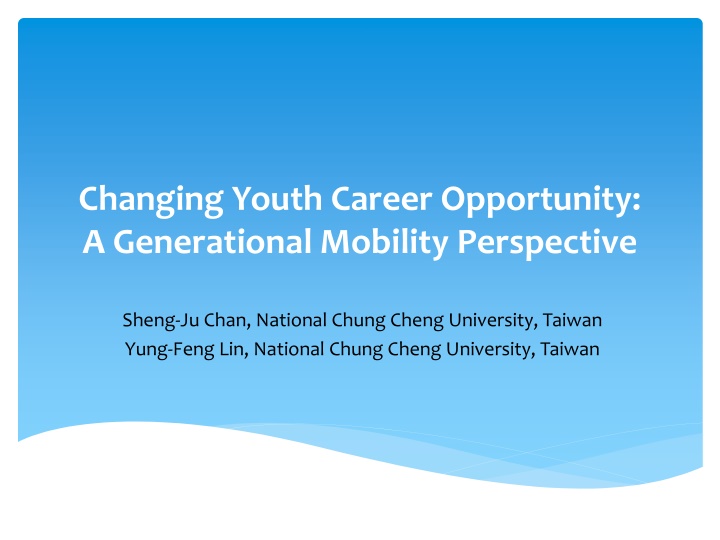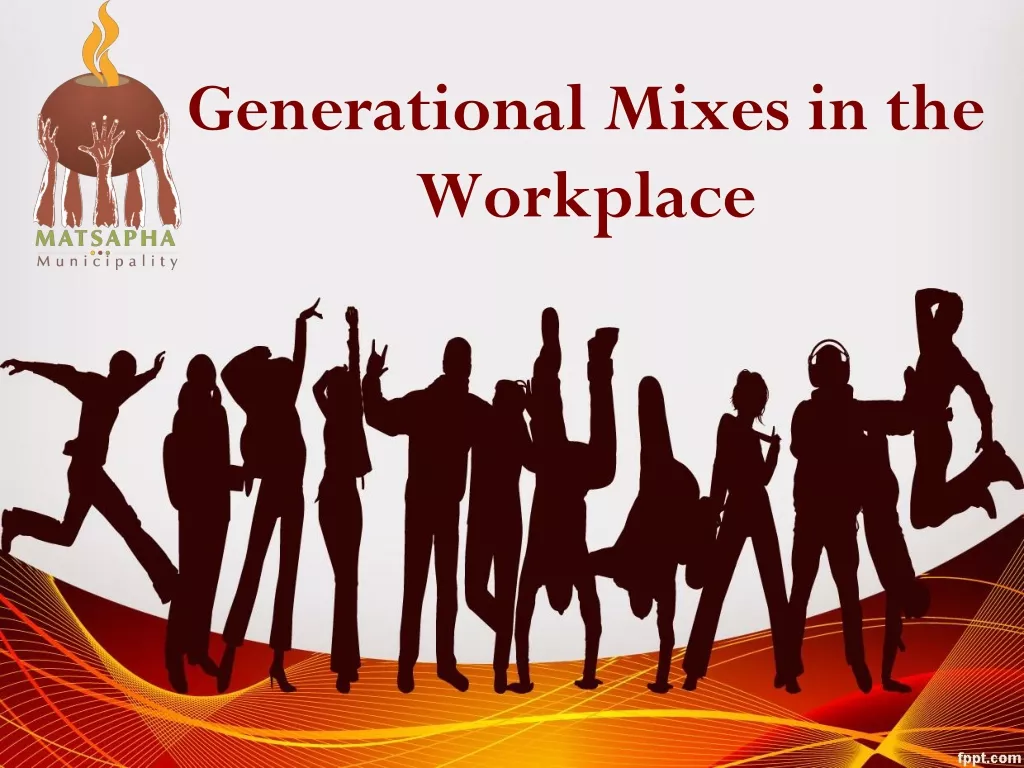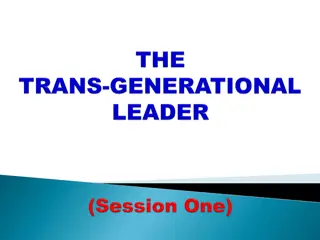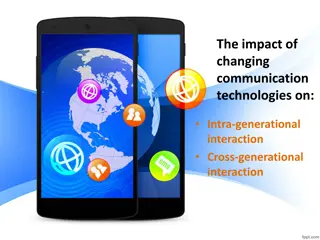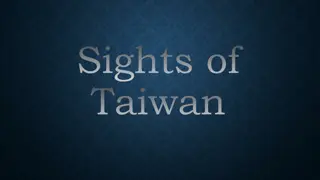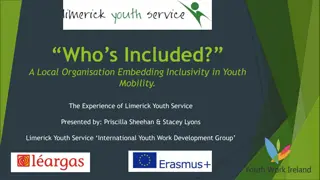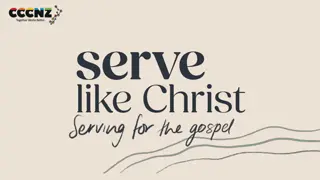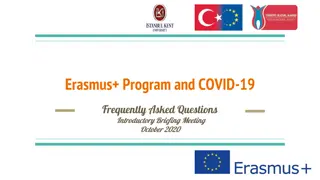Changing Youth Career Opportunities in Taiwan: A Generational Mobility Perspective
Examining the impact of massification of higher education on youth career prospects in Taiwan, this study delves into the evolving structures of career opportunities for different generations. It explores how education influences the transition from entry-level positions to professional roles, analyzing trends in the number of higher education institutions and student enrollment levels. The research questions the correlation between higher education attainment and improved career prospects in the competitive job market.
Download Presentation

Please find below an Image/Link to download the presentation.
The content on the website is provided AS IS for your information and personal use only. It may not be sold, licensed, or shared on other websites without obtaining consent from the author.If you encounter any issues during the download, it is possible that the publisher has removed the file from their server.
You are allowed to download the files provided on this website for personal or commercial use, subject to the condition that they are used lawfully. All files are the property of their respective owners.
The content on the website is provided AS IS for your information and personal use only. It may not be sold, licensed, or shared on other websites without obtaining consent from the author.
E N D
Presentation Transcript
Changing Youth Career Opportunity: A Generational Mobility Perspective Sheng-Ju Chan, National Chung Cheng University, Taiwan Yung-Feng Lin, National Chung Cheng University, Taiwan
An Expanded sector: massification of HE in Taiwan Youth cohort in different eras might face different career opportunities, in particular, in a changing social and economic context. One of the major opportunities is how they progressed after they leave schools. There has been an ongoing debate with respect to the changing opportunities of youth career.
Transitional Path: The relative opportunity Youth has to progress from lower occupational ladder to better workforce positions from early career such as 20 years old to 40s. Education is widely seen as a worthwhile investment for brighter future, according to the Human Resource Argument. Well-educated youth tend to be regarded as better equipped in competitive labour market. Degree holders aims to occupy decent jobs with better salary aspiring to retain managerial or professional status. Within the same age cohort, youth might has similar opportunity structure.
Number of higher education institutions by type 180 160 140 120 100 80 60 40 20 0 1994 1995 1996 1997 1998 19992000 2001 2002 2003200420052006200720082009 2010 2011 2012 Universities Colleges Junior colleges Total
Number of students in HE, by level 1,200,000 1,000,000 800,000 600,000 400,000 200,000 0 Doctoral Master Undergraduate Junior college
Generational Mobility Massification of higher education leads to increased number of young people with university qualifications. Receiving higher education has cost them or their parents a lots in terms of rising tuition fees and living expenditure. Competitive workforce market also pose great threat to unemployment for young people. Does it mean a better prospect of career for young people?
Research Question This study using Taiwan as a case will examine whether different generations of youth have faced various career opportunity structures. Our intention is to explore the relative career opportunities of youth with associate or higher degrees being mobile to professional and semi- professional positions through longitudinal analysis.
Research Design and Method logistic regression is used as statistical technique to calculate the different odds of various age cohorts (benchmarking age cohort is 40-44 years). The timeframe is between 1994 and 2014 with five year as interval. The results can shed lights on whether earlier generations enjoy better chance at upward occupational mobility or not.
The Design of Timeframe and Age Cohort 1994 1999 2004 Year 20-24y(born1970-1974) 25-29y(born1965-1969) 30-34y(born1960-1964) 35-39y(born1955-1959) 40-44y(born1950-1954) 20-24y(born1975-1979) 25-29y(born1970-1974) 30-34y(born1965-1969) 35-39y(born1960-1964) 40-44y(born1955-1959) 20-24y(born1980-1984) 25-29y(born1975-1979) 30-34y(born1970-1974) 35-39y(born1965-1969) 40-44y(born1960-1964) Age cohort 2009 2014 Year 20-24y(born1985-1989) 25-29y(born1980-1984) 30-34y(born1975-1979) 35-39y(born1970-1974) 40-44y(born1965-1969) 20-24y(born1990-1994) 25-29y(born1985-1989) 30-34y(born1980-1984) 35-39y(born1975-1979) 40-44y(born1970-1974) Age cohort
Data Source and Quality Data source: Manpower Survey Statistics in Taiwan administered by Directorate-General of Budget, Accounting and Statistics, Executive Yuan, R.O.C (Taiwan) This is an annual survey targeting at persons beyond 15 years old. It adopts stratified two-stage random sampling method interviewing 20,400 household per year.
Focusing on university/college graduates In order to accommodate the rapid upgrading of tertiary sector in Taiwan for the past two decades (please see previous introduction), we concentrate on associate / sub degree and higher degree holders Professional and semi-professional job: it is based on the definitions in the Classification of Occupations, according to the levels of techniques/ knowledge, given by the Directorate- General of Budget, Accounting and Statistics, Executive Yuan, R.O.C (Taiwan) Five levels of jobs: elected representative member, CEOs and manager(L4 &3), professional staff (L4), technicians and assistant professionals (L3), semi-manual (L2), and manual (L1)
Five levels of jobs: 1. elected representative member, CEOs and manager(L4 &3), 2. professional staff (L4), 3. technicians and assistant professionals (L3), 4. semi-manual (L2), and 5. manual (L1)
Sampling 1994 1999 2004 2009 2014 Surveyed Nationwide 727,748 726,535 718,603 700,407 683,003 39,772 (5.47%) 48,267 (6.64%) 58,481 (8.14%) 64,875 (9.26%) 78,946 (11.56%) Sampled Samples are those who Degree and sub-degree holders with professional and semi-professional jobs
Occupations Professionals Semi-professionals Level of education Managerial positions Professional position Technicians; and assistant Professional Sum Sub-degree holders 2,400 4,753 13,764 20,917 1994 Degree holders 2,341 8,531 7,983 18,855 Sub-degree holders 2,235 4,357 16,701 23,293 1999 Degree holders 2,349 11,601 11,024 24,974 Sub-degree holders 1,872 4,567 16,145 22,584 2004 Degree holders 2,743 16,186 16,968 35,897 Sub-degree holders 1,238 3,669 12,410 17,317 2009 Degree holders 2,772 18,441 26,345 47,558 Sub-degree holders 523 10,113 4,746 15,382 2014 Degree holders 2,290 46,450 14,824 63,564
Logistics regression results Exp(B) Age Cohort 1994 1999 2009 2014 2004 occupations Professional .553 .771 .396 .413 .703 20-24 years Semi-pro 2.420 1.807 1.296 2.528 1.422 Professional .598 .782 .497 .482 .728 25-29 years Semi-pro 2.073 1.671 1.279 2.011 1.373 Professional .750 .868 .767 .656 .897 30-34 years Semi-pro 1.524 1.333 1.152 1.303 1.115 Professional .892 1.121 .911 1.097 .816 1.226 .812 1.231 .971 1.030 35-39years Semi-pro Note: 1. The Exp(B) is benchmarked with age cohort of 40-44 years olds. 2. Independent variable is different age cohort while dependent variables is occupations level.
Relative expectance opportunity 300% 250% 200% 150% 100% 50% 0% Pro Semi-pro Pro Semi-pro Pro Semi-pro Pro Semi-pro 20-24y 25-29y 30-34y 35-39y 1994 1999 2004 2009 2014
Generations Matter When examining the changing statistical expectance values, the 20-24 years group were only 41.3% at the professional position in 1994 compared to 40-44 years group. Looking at the same age groups, the expectance figure has risen to 55.3% in 1999, 77.1% in 2004 and 70.3% in 2014 (except 2009).
Generations Matter This general pattern seems to suggest that the latter generations have better chance at the professional position compared to previous generations. This peaks in 2004. They tend to have higher expectancy odds with previous generations. Although the senior remain strong. Although all age cohort have better prospect. The global financial crisis had a obvious negative impact upon the relative odds for all different age groups as seen in 2009 statistics.
Relative expectancies of professional position 120% 100% 80% 60% 40% 20% 0% 1994 1999 2004 2009 2014 20-24y 25-29y 30-34y 35-39y
Relative expectancies of semi-professional position 300% 250% 200% 150% 100% 50% 0% 1994 1999 2004 2009 2014 20-24y 25-29y 30-34y 35-39y
Generations Matter In general, almost for all age groups (to professional) In each era, elder groups have higher opportunities Over year, each age group have more opportunities In general, almost for all age groups (to semi-professional ) In each era, younger groups have higher opportunity Over year, each age group have less opportunities
Initial Observations For the past two decades, more professional positions (although not managerial ones) have been created along with the rapid increased number of degree and sub-degree holders (higher education expansion). For younger generation, the relative opportunities of being upward to the semi-professional and professional position are higher than their elder cohort.
Initial Observations It terms of different age cohorts, the elder, as expected, have greater opportunities in securing professional positions but not semi-professional ones. That is because there has a trade-off situation between professional and semi-professional positions. More people moved up to professional positions while growing older.(is it a sign of non-meritocracy)
Discussion Generational immobility? There has been lots of debates about whether the young generations, particularly after 2000s, have faced stagnant occupational structures with limited upward mobility chances or not. However, our empirical evidence seems to suggests that Taiwanese current youth, compared to those in 1990s, do have better occupational opportunities. For all different age cohort groups, year 2014 has higher expectance odds than other surveyed years except 2004, the peak year.
Career path and changing economic structure In this cross-sectoral study, Taiwanese better upward mobility opportunity for recent generations points out that the upgraded economic structure and labour market might be able to offer sufficient or more professional positions. This findings seems to justify the ongoing needs about continuous expansion of higher education so as to provide more skilled workforce for knowledge-based economy. However, other indicators and statistics suggest that we also should treat this result carefully.
Unemployment rates in Taiwan 7.00 6.00 5.98 5.75 5.62 5.40 5.18 5.38 5.13 5.00 5.10 4.78 4.70 4.51 4.51 4.11 4.36 4.26 4.23 4.26 4.00 4.04 4.04 3.94 3.91 3.89 3.82 3.32 3.12 2.69 2.67 3.11 3.00 2.98 2.67 2.00 1.00 - 1998 1999 2000 2001 2002 2003 2004 2005 2006 2007 2008 2009 2010 2011 2012 Upper secondary and post-secondary non-tertiary Tertiary education
Declining average wages (after inflation adjustment in $NT Dollars) 60,000 55,000 50,000 45,000 40,000 35,000 30,000 25,000 20,000 2000 2001 2002 2003 2004 2005 2006 2007 2008 2009 2010 2011 2012 Junior High School and Below Senior High School Junior College College and University
Average wage from 2000 to 2012 (percent) 0 80 2000 2001 2002 2003 2004 2005 2006 2007 2008 2009 2010 2011 2012 70 -5 60 -10 50 -15 40 30 -20 20 -25 10 -30 0 Senior High Schoool Junior College College and University Net Enrollment Rate
Questions emerge Nearly major media and press highlights that contemporary youths have been difficult in securing jobs and stuck in career progress and development. Having a professional job is not easy according to mass media. Referring back to the literature review, it also has demonstrated that the average salary for the past decades is declining substantially in real terms. This indicator seems to be inconsistent with the previous findings, i.e. better upward mobility opportunity for young persons.
Initial conclusion Labour market does generate more professional positions in the past decades in Taiwan However, these new created jobs were not well paid. This leads to two possible hypothesis for such divide labour market development: -- Cost down in human resource (global auction?) -- job title inflation
Temporary explanation -- Cost down in human resource (global/local auction) Brown, Lauder, and Ashton (2011) argued that the supposed better jobs, in particular managerial or professional jobs, are not as many as expectedbecause in knowledge capitalism, as compared with industrial capitalism in the twentieth century, a talented minority of top performers make greater contributions than others. The global labor market is increasingly filled with a more highly skilled labor force. Furthermore, the outsourcing of high-skilled work to other counties is intensified because of lower prices and better quality workforces that are available across borders. It follows that employers are now able to, in global or local auction, use less cost on valuable skilled workforce particularly for professionals. This might echo the model of costdown model commonly adopted by many Taiwanese industrial sector.
Temporary explanation -- Job title inflation/ credential inflation The second hypothesis suggest that these professional positions are in name only rather than require degree holders with corresponding capacity. On the one hand, a significant increase in the number of professional position, other than managerial ones, implies the changing nature of occupation toward a high skills economy. On the other hand, it might be a cultural preference for naming the positon higher rank with supposed higher social status. As a result, more professional positions do not necessarily means a stronger competitiveness, nor do it mean better rewards.
